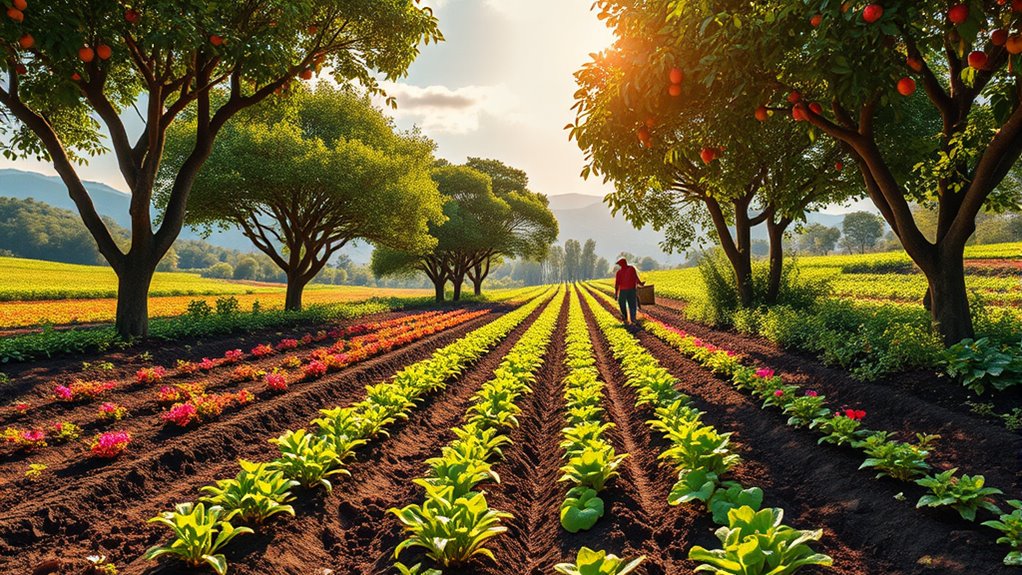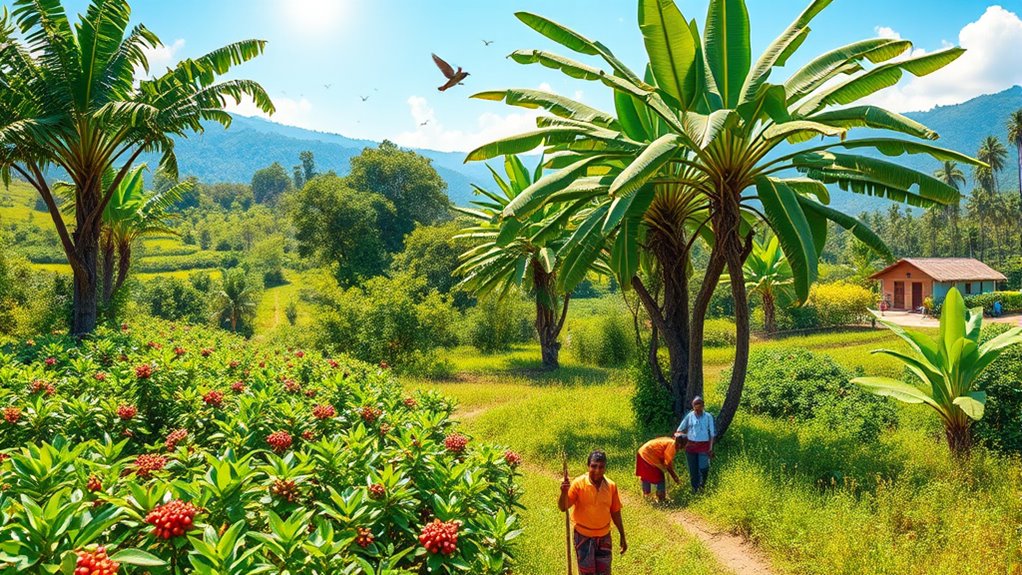Agroforestry boosts your income and biodiversity by combining trees with crops and livestock, creating a diverse, resilient farm system. This approach improves soil health, controls pests naturally, and offers multiple income sources through direct sales, niche markets, and crop insurance. It also provides habitats for local wildlife, supporting biodiversity. By adopting agroforestry, you’ll enhance farm stability and environmental sustainability—if you want to discover more, keep exploring how these systems work together.
Key Takeaways
- Diversification of crops and integration of trees create multiple income streams, reducing financial risk and increasing overall farm earnings.
- Agroforestry enhances biodiversity by providing habitats and food sources for wildlife, supporting ecological resilience.
- Improved soil health and water management boost crop yields and reduce input costs, increasing farmer profitability.
- Diverse plant layers attract beneficial insects and pollinators, improving crop productivity and ecological balance.
- Community engagement and policy incentives promote sustainable practices, expanding income opportunities while conserving biodiversity.
Enhancing Farm Productivity Through Diversification

Diversification in agroforestry systems can considerably boost your farm’s productivity. By practicing crop diversification, you spread out risk and utilize your land more efficiently. Intercropping benefits your farm by allowing you to grow different crops simultaneously, which can improve soil health, suppress pests, and maximize space. When you combine trees with crops, you create a mutually beneficial environment that enhances overall yield. This approach reduces reliance on a single crop, making your farm more resilient to market fluctuations and weather changes. With diverse plantings, you also optimize resource use, like sunlight and water, boosting productivity. Additionally, integrating AI-driven insights can help farmers analyze and optimize their crop choices for better yields. Ultimately, crop diversification through agroforestry not only increases your farm’s output but also promotes a sustainable, balanced ecosystem.
Increasing Income Stability With Multiple Revenue Streams

By generating multiple revenue streams through agroforestry, you can substantially enhance your farm’s financial stability. Diversifying your income reduces reliance on a single crop, making your farm more resilient to market fluctuations and climate risks. With better market access, you can sell your varied products directly to consumers or specialty markets, often at higher prices. Additionally, agroforestry systems can improve eligibility for crop insurance, helping protect your income during adverse weather events or pest outbreaks. These multiple streams—such as timber, fruits, nuts, and traditional crops—provide steady cash flow throughout the year, minimizing income gaps. Incorporating wall organization systems can also help you keep track of your diverse products and manage your farm efficiently. Overall, agroforestry not only boosts your earnings but also creates a more predictable, secure financial future for your farm.
Promoting Sustainable Land Use and Soil Health

Implementing agroforestry practices encourages sustainable land use and enhances soil health, which benefits both your farm’s productivity and the environment. A diverse tree canopy protects the soil from erosion, moderates temperature fluctuations, and improves water retention. Roots from trees and crops reduce soil compaction, allowing air and nutrients to circulate more freely. This promotes healthy microbial activity, leading to better nutrient cycling and increased fertility over time. By integrating trees into your land, you prevent overuse and degradation, supporting long-term productivity. Properly managed agroforestry systems maintain soil structure and prevent the negative effects of soil compaction caused by heavy machinery or overgrazing. Additionally, the use of high-quality projectors in educational and training programs can help farmers better understand the benefits and management of agroforestry systems. As a result, your land becomes more resilient, sustainable, and capable of supporting diverse crops for years to come.
Supporting Wildlife Habitat and Biodiversity Conservation

Have you considered how agroforestry can create a thriving habitat for local wildlife? By integrating trees and shrubs into your farm, you promote habitat connectivity and support biodiversity. Here’s how:
- Wildlife corridors link fragmented habitats, allowing animals to move safely across landscapes.
- Diverse plant layers provide food and shelter for birds, insects, and mammals.
- Maintaining native vegetation helps preserve rare and endangered species.
- Implementing effective fraud prevention tools in your farm management ensures the security of transactions related to agroforestry initiatives. Agroforestry enhances habitat connectivity, ensuring wildlife can thrive alongside your farming activities. It creates safe passageways that reduce habitat fragmentation, fostering a balanced ecosystem. Supporting these natural corridors benefits biodiversity and strengthens ecological resilience. Your farm becomes a sanctuary for local wildlife, contributing to conservation efforts while promoting sustainable land use. In doing so, you support a healthier environment and a more resilient farm ecosystem.
Reducing Environmental Impact and Carbon Footprint

Integrating agroforestry into your farming practices can substantially lower your environmental impact and carbon footprint. By planting trees alongside crops and livestock, you promote carbon sequestration, which helps absorb excess CO₂ from the atmosphere. These trees act as natural carbon sinks, reducing your farm’s overall greenhouse gas emissions. Additionally, agroforestry systems encourage the use of renewable energy sources, like solar-powered equipment and biomass from pruned trees, decreasing reliance on fossil fuels. This shift not only cuts emissions but also fosters sustainable energy use on your farm. Moreover, noise levels of modern heat pumps are designed to be very quiet, which can be beneficial if you’re integrating renewable energy systems like solar-powered equipment on your farm. Overall, adopting agroforestry practices creates a more eco-friendly operation, helping to combat climate change while maintaining productive, resilient land. You’re actively contributing to a healthier environment with every tree you plant.
Building Resilience Against Climate Variability

By integrating diverse crops, you create a buffer against climate fluctuations, reducing the risk of total crop failure. Natural water management techniques help conserve moisture and prevent erosion during extreme weather events. Improving soil fertility guarantees your land remains productive, even under unpredictable climate conditions. Additionally, implementing water conservation strategies inspired by water parks can enhance water efficiency and resilience on your farm.
Diverse Crop Integration
Diverse crop integration strengthens farmers’ resilience against climate variability by spreading risk across different plant types. By practicing crop rotation, you reduce soil exhaustion and pest buildup, helping your farm withstand unpredictable weather. Mixing crops also improves pest management naturally, lowering the need for chemicals. To deepen your understanding:
- Rotating crops minimizes vulnerability to pests and diseases.
- Diverse plant varieties buffer against droughts and floods.
- Intercropping creates a more resilient ecosystem, supporting biodiversity and productivity.
This approach ensures that if one crop underperforms due to weather shifts, others can thrive, maintaining your income and safeguarding your land’s health. With diverse crop integration, you create a more adaptable, sustainable farming system.
Natural Water Management
Implementing natural water management techniques can substantially boost your farm’s resilience to climate variability. By enhancing natural water storage, you guarantee that your soil retains moisture during dry periods, reducing drought risks. Incorporating watershed management practices helps direct runoff and conserve water across your land, preventing erosion and improving water availability. Planting cover crops and maintaining tree buffers support the natural filtration of water and slow its flow, promoting recharge of underground aquifers. These strategies work together to create a more reliable water supply, even during unpredictable weather patterns. Additionally, introducing low light office plants can improve the microclimate of farm buildings and surrounding areas, contributing to overall farm resilience. With better water management, you protect your crops from extreme droughts and floods, strengthening your farm’s ability to adapt. Ultimately, natural water management enhances both your farm’s stability and local biodiversity.
Soil Fertility Enhancement
Enhancing soil fertility is crucial for building your farm’s resilience against climate variability. Healthy soil supports robust plant growth and helps withstand droughts or heavy rains. To boost soil fertility, focus on nurturing soil microbial communities, which naturally improve nutrient cycling. Incorporate organic amendments like compost, manure, or cover crops to add essential nutrients and organic matter. These practices create a thriving environment for beneficial soil microbes, which enhances soil structure and moisture retention. Consider these strategies:
- Apply organic amendments regularly to enrich soil nutrients.
- Use cover crops to protect and build soil organic matter.
- Promote soil microbial activity through reduced tillage and organic inputs.
- Understanding soil health and its management is vital for sustainable farming.
Together, these actions improve soil health, making your farm more resilient to unpredictable weather patterns.
Encouraging Community Engagement and Knowledge Sharing

Community engagement and knowledge sharing are essential for the successful adoption of agroforestry practices. When you encourage peer-to-peer learning, farmers can share experiences, troubleshoot challenges, and refine techniques together. Community-led demonstrations serve as practical examples, showing tangible results and inspiring others to participate. These approaches foster trust and collective problem-solving, making new practices more acceptable and sustainable. By actively involving local farmers in decision-making and knowledge exchange, you create a sense of ownership and motivation. This collaborative environment accelerates learning, reduces uncertainty, and strengthens social bonds. Promoting education about biodiversity and sustainable practices helps to build awareness and support for agroforestry initiatives. Ultimately, engaging your community ensures that agroforestry benefits are widely understood, adopted, and maintained over time, benefiting both income levels and biodiversity.
Policy Support and Incentives for Agroforestry Adoption

Policy support and financial incentives play a crucial role in encouraging farmers to adopt agroforestry practices. When governments implement effective policy frameworks, they create a conducive environment for farmers to embrace sustainable land use. Here are three ways policies boost adoption:
Effective policies and incentives are vital for promoting agroforestry adoption among farmers.
- Providing targeted government incentives, such as grants and subsidies, lowers upfront costs.
- Establishing clear policy frameworks ensures farmers understand long-term benefits and requirements.
- Offering technical assistance and training through government programs builds confidence and expertise.
These measures motivate farmers by reducing financial risks and clarifying expectations. By aligning policies with on-the-ground realities, governments can enhance the widespread adoption of agroforestry, ultimately boosting farmer income and biodiversity simultaneously.
Frequently Asked Questions
How Does Agroforestry Affect Local Water Resources?
Agroforestry positively impacts your local water resources by enhancing soil retention and water filtration. The trees and plants in agroforestry systems reduce soil erosion, helping retain water in the soil and prevent runoff. Their root systems filter rainwater, improving water quality by trapping pollutants. This sustainable approach guarantees your water sources stay cleaner and more reliable, supporting both your farm’s productivity and the surrounding ecosystem.
What Are the Initial Costs of Implementing Agroforestry Systems?
Considering costs can seem challenging, but your careful cost-benefit analysis guarantees initial investments. You’ll need to budget for things like saplings, soil preparation, and labor, which can seem steep at first. However, these initial costs lay the foundation for long-term gains, including increased yields and biodiversity. By evaluating these expenses early, you confirm sustainable success while balancing budget and benefits, turning initial investments into lasting rewards.
How Do Farmers Choose Suitable Tree and Crop Combinations?
When choosing suitable tree and crop combinations, you should focus on effective tree crop pairing and consider your farm’s specific conditions. Farmer decision making involves examining soil type, climate, and water availability to select compatible species that enhance growth and yield. You also evaluate how different trees and crops interact, ensuring they benefit each other while supporting biodiversity. This thoughtful process optimizes productivity and sustainability on your farm.
Can Agroforestry Practices Be Adapted to Different Climate Zones?
Climate adaptability is vital, and you can customize agroforestry practices to different climate zones. By blending regional practices with innovative planting techniques, you guarantee your farm thrives regardless of weather changes. You adjust tree and crop choices to suit local conditions, creating a resilient, rewarding system. Embracing this adaptable approach helps you maximize productivity and biodiversity, no matter your climate zone, making your farming future flexible and fruitful.
What Role Does Technology Play in Managing Agroforestry Systems?
Technology plays a vital role in managing agroforestry systems. You can use remote sensing to monitor crop health, soil conditions, and tree growth efficiently. Data analytics helps you analyze this information, enabling informed decisions for sustainable practices. By leveraging these tools, you optimize productivity, conserve resources, and promote biodiversity, ensuring your agroforestry system remains resilient and profitable while supporting ecological health.
Conclusion
Imagine your farm as a vibrant tapestry, each thread representing diverse crops and trees that strengthen the whole. By adopting agroforestry, you not only boost your income and protect biodiversity but also create a resilient, sustainable landscape. Just like a well-woven fabric endures wear, your farm becomes more adaptable to climate shifts and market changes. Embrace agroforestry, and watch your land flourish like a thriving, interconnected ecosystem.






